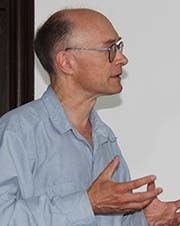Using Near-Surface Geophysics to Estimate Soil and Rock Physical Properties
OR
SEG members, view the course for free!
Format: Virtual Webinar. 45 min. presentation followed by 15 min. Q&A
An optional post-lecture workshop will immediately follow each lecture for expanded Q&A and networking
Session 1, Wednesday, Feb 2, 2022, 4 pm to 5 pm Central European Time
Session 2, Thursday, April 7, 2022, 3 pm to 4 pm British Summer Time
Past SEG Recordings SEG Members Free Access Details
Two live sessions are completed. Please scroll down to watch the videos from the recordings below. SEG members, view the course for free!
Abstract
The shallow subsurface contains soil, glacial, and alluvial deposits as well as weathered and/or fractured bedrock. It is from these thin surficial layers that we draw our drinking water and produce our food, and it is also where we ultimately discharge much of our waste. Recent history has taught us that overuse, let alone abuse, of our environment, may lead to the long-term detriment to our livelihood. In densely populated and highly industrialized regions, the protection and sustainable use of this fragile surficial environment have therefore become a societal and political issue of critical importance. Near-surface geophysics has an essential role to play in this endeavor and has seen correspondingly dramatic growth and evolution during the recent past. While state-of-the-art near-surface geophysical techniques have a proven capacity to provide realistic structural images and characterizations of the surficial environment, there also is an emerging trend towards using this information to infer estimates of soil and rock physical properties. This is a focus of our research group. Specifically, we are interested in relating relatively easy-to-measure geophysical data and their associated proxy parameters to more elusive rock and soil physical properties, such as permeability or fracture compliance, which tend to be difficult to infer through direct techniques. To achieve this objective, we pursue two fundamentally different, yet highly complementary, approaches, which will be introduced and discussed in this lecture through selected case studies. Our first approach is based on the idea of using geostatistical techniques for integrating spatially sparse, point-type measurements of soil or rock physical target properties with spatially extensive geophysical images of corresponding proxy parameters. A distinct advantage of this approach is that it naturally closes the notoriously large gaps in terms of spatial resolution and coverage associated with such datasets and, additionally, provides some measure of the uncertainty of the inferred distributions of the target properties. Conversely, our second approach is more direct in that it seeks to directly relate specific attributes of ground-penetrating radar and seismic data to the underlying soil or rock physical target properties.

Figure 1. Estimating the detailed porosity distribution in a heterogeneous surficial aquifer from surface-based ground-penetrating radar (GPR) data. a) 3D surface-based GPR data from the Boise Hydrogeophysical Research Site (BHRS). The data were acquired in a bi-static common-offset manner at a nominal center frequency of 100 MHz. b) Porosity distribution inferred from the stochastic simulation of the GPR data conditional to information provided by neutron-neutron borehole logs. c) Comparison of observed (top row) and synthetic (bottom row) GPR data along selected inline profiles. The latter is consistent with the inferred porosity distribution. This is a work in progress courtesy of Zhiwei Xu (formerly the University of Lausanne, now the China University of Geosciences). See also Xu et al., GEOPHYSICS, 86, WB147-WB157, 2021.
Your Instructor

Klaus Holliger Klaus Holliger received MSc and PhD degrees in geophysics from ETH Zurich, Switzerland, as well as a postgraduate degree in economics from the University of London. After a postdoc at Rice University in Houston, Texas, he joined ETH Zurich's newly founded Applied and Environmental Geophysics Group. He then moved to a chaired professorship at the University of Lausanne, where he served as vice-dean of research, head of the Institute of Geophysics, and head of the Center for Research of the Terrestrial Environment. He also holds adjunct-type professorships at ETH Zurich and Zhejiang University in Hangzhou, China. In addition to earlier distinctions, Klaus has received SEG’s Harold Money and Frank Frischknecht Leadership Awards for his more recent work. As a founding member of the Applied and Environmental Geophysics Group of ETH Zurich, he also shared SEG’s Distinguished Service Award. Klaus has served as president of the Near Surface Geophysics Section of SEG, as editor-in-chief of the Journal of Applied Geophysics, as associate editor of GEOPHYSICS, Water Resources Research, Geology, and Solid Earth, and as co-editor of several books and special issues. His primary research interest is hydrogeophysics sensu lato.
